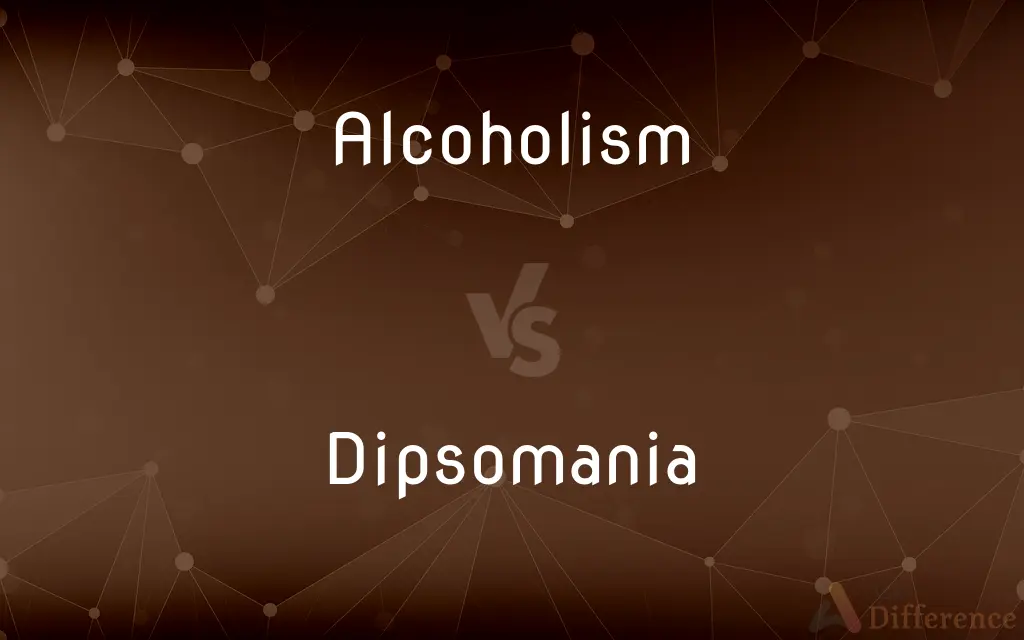Alcoholism vs. Dipsomania — What's the Difference?
By Urooj Arif & Maham Liaqat — Updated on April 3, 2024
Alcoholism is a broad condition of dependence on alcohol, while dipsomania refers to an uncontrollable craving for alcohol at irregular intervals.

Difference Between Alcoholism and Dipsomania
Table of Contents
ADVERTISEMENT
Key Differences
Alcoholism, also known as alcohol dependence, is a chronic condition characterized by the compulsive use of alcohol despite adverse health, social, and legal consequences. It involves a physical and psychological dependence on alcohol. Dipsomania, on the other hand, is a less commonly used term that describes an occasional, intense craving for alcohol, often leading to bouts of excessive drinking after long periods of abstinence.
While alcoholism is recognized widely in the medical community and includes a spectrum of unhealthy alcohol use patterns, dipsomania is considered a more specific and somewhat outdated term. Alcoholism encompasses a range of behaviors from binge drinking to a constant, overwhelming need to consume alcohol. In contrast, dipsomania is seen as a sudden urge to drink excessively, which can be sporadic and not necessarily daily.
The treatment for alcoholism typically involves a comprehensive approach, including detoxification, counseling, medication, and support groups. This reflects the condition's complexity and its impact on various aspects of an individual's life. For dipsomania, while specific treatments are less standardized due to its less frequent use as a diagnosis, interventions would similarly focus on managing the individual's triggers and urges, alongside broader support for alcohol dependence.
The diagnosis of alcoholism often requires a sustained pattern of alcohol abuse that leads to significant impairment or distress. This includes a strong desire to drink, unsuccessful efforts to cut down on drinking, and withdrawal symptoms when alcohol use is decreased. Dipsomania, however, is characterized more by episodic, intense cravings that can result in temporary but extreme disruptions to one’s life.
Understanding the distinction between alcoholism and dipsomania is crucial for providing appropriate care and support. Alcoholism requires a long-term, often lifelong, commitment to recovery and management. Dipsomania, while it involves intense cravings, may not always entail a continuous dependence on alcohol, offering different challenges and potentially requiring different strategies for intervention and support.
ADVERTISEMENT
Comparison Chart
Definition
A chronic disease characterized by an inability to control or cease alcohol use despite adverse consequences.
An outdated term describing an overwhelming urge to consume alcohol in bouts, often after periods of abstinence.
Frequency of Use
Regular and continuous use of alcohol.
Sporadic, intense cravings leading to excessive drinking.
Treatment
Comprehensive, including detox, counseling, medication, and support groups.
Less standardized; focuses on managing triggers and overall support for alcohol dependence.
Diagnosis Criteria
Pattern of alcohol abuse, strong desire to drink, difficulty in controlling consumption, and withdrawal symptoms.
Characterized mainly by episodic, intense cravings without the constant need for alcohol.
Impact
Affects various aspects of life, requiring long-term management.
May result in temporary but extreme disruptions, with less constant dependence on alcohol.
Compare with Definitions
Alcoholism
A chronic condition marked by uncontrolled alcohol use.
John's alcoholism affected his health and relationships.
Dipsomania
Describes an intense, episodic craving for alcohol.
Despite periods of sobriety, Peter's dipsomania led to unpredictable binges.
Alcoholism
Requires ongoing commitment to recovery and support systems.
Linda attends regular support group meetings to manage her alcoholism.
Dipsomania
Less recognized compared to alcoholism, with some considering it an outdated term.
Few people outside of professional circles are familiar with the term dipsomania.
Alcoholism
Involves a multifaceted approach including medical and psychological support.
Maria found support for her alcoholism through therapy and medication.
Dipsomania
Aimed at coping strategies for cravings and long-term sobriety.
Therapy for dipsomania includes identifying triggers and learning coping mechanisms.
Alcoholism
Can lead to serious health, social, and economic problems.
Due to his alcoholism, Alex faced legal and financial issues.
Dipsomania
Once a more common diagnosis, now less frequently used.
In the past, dipsomania was distinguished separately from other forms of alcoholism.
Alcoholism
Widely acknowledged and treated in medical and social services.
Alcoholism is recognized as a major public health issue worldwide.
Dipsomania
Considered a more specific form of alcohol use disorder.
Dipsomania is often viewed through the lens of broader alcohol addiction issues.
Alcoholism
Alcoholism is, broadly, any drinking of alcohol that results in significant mental or physical health problems. Alcoholism is not a recognized diagnostic entity.
Dipsomania
Dipsomania is a historical term describing a medical condition involving an uncontrollable craving for alcohol. In the 19th century, the term dipsomania was used to refer to a variety of alcohol-related problems, most of which are known today as alcohol use disorder.
Alcoholism
Addiction to the consumption of alcoholic drink; alcohol dependency
He had a long history of depression, drug abuse, and alcoholism
Dipsomania
Alcoholism, specifically in a form characterized by intermittent bouts of craving for alcohol.
Alcoholism
A disorder characterized by a persistent pattern of alcohol use that causes harm or distress. It typically involves cravings for alcohol, inability to control the amount consumed, withdrawal symptoms in its absence, and the need to consume greater quantities in order to feel the same effects, and often results in impaired social functioning and significant damage to physical health.
Dipsomania
An insatiable craving for alcoholic beverages.
Alcoholism
A chronic disease caused by compulsive and uncontrollable consumption of alcoholic beverages, leading to addiction and deterioration in health and social functioning.
Dipsomania
(disease) Addiction to alcohol.
Alcoholism
(pathology) Acute alcohol poisoning.
Dipsomania
Specifically periodic alcoholism, characterized by bouts of heavy drinking rather than continuous indulgence in alcohol.
Alcoholism
A diseased condition of the system, brought about by the continued use of alcoholic liquors.
Dipsomania
A morbid an uncontrollable craving (often periodic) for drink, esp. for alcoholic liquors; also improperly used to denote acute and chronic alcoholism.
Alcoholism
Habitual intoxication; prolonged and excessive intake of alcoholic drinks leading to a breakdown in health and an addiction to alcohol such that abrupt deprivation leads to severe withdrawal symptoms
Dipsomania
An intense persistent desire to drink alcoholic beverages to excess
Alcoholism
An intense persistent desire to drink alcoholic beverages to excess
Common Curiosities
What is alcoholism?
Alcoholism is a chronic disease characterized by an inability to control alcohol use despite negative consequences.
Can someone with dipsomania also be considered an alcoholic?
Yes, dipsomania can be seen as a specific manifestation of alcoholism, particularly in its episodic intensity.
Is dipsomania recognized as a separate condition in modern medicine?
Today, dipsomania is less commonly recognized as a separate condition and is more often considered under the broader category of alcohol use disorders.
What support is available for people with alcoholism?
Support ranges from medical treatment and counseling to support groups and rehabilitation programs.
What is dipsomania?
Dipsomania is an outdated term for an intense, episodic craving for alcohol, leading to excessive drinking.
Are there any famous cases of dipsomania?
Historical literature and reports may reference dipsomania, but it is now more commonly discussed within the context of alcohol use disorders.
How is alcoholism diagnosed?
Diagnosis involves identifying a pattern of alcohol use that leads to significant impairment or distress.
Is there a genetic component to alcoholism or dipsomania?
Yes, genetics can play a significant role in the development of alcohol use disorders, including alcoholism and potentially dipsomania.
What causes dipsomania?
Like alcoholism, dipsomania can be influenced by genetic, psychological, and social factors.
How do alcoholism and dipsomania differ in treatment?
Alcoholism requires a comprehensive treatment approach, while dipsomania, though less commonly addressed separately, would focus on managing intense cravings.
Can dipsomania be cured?
While there's no cure for alcohol use disorders, effective management and treatment can lead to long-term recovery.
What role does willpower play in managing alcoholism or dipsomania?
While personal commitment is crucial, successful management often requires professional treatment and support systems.
How do societal views on alcoholism and dipsomania differ?
Alcoholism is widely recognized as a serious condition, whereas dipsomania is less known and often not distinguished in public discourse.
How can family and friends support someone with alcoholism or dipsomania?
Support can include encouraging treatment, offering emotional support, and participating in family therapy or support groups.
Share Your Discovery

Previous Comparison
Landscape vs. Cityscape
Next Comparison
Distant vs. AloofAuthor Spotlight
Written by
Urooj ArifUrooj is a skilled content writer at Ask Difference, known for her exceptional ability to simplify complex topics into engaging and informative content. With a passion for research and a flair for clear, concise writing, she consistently delivers articles that resonate with our diverse audience.
Co-written by
Maham Liaqat














































